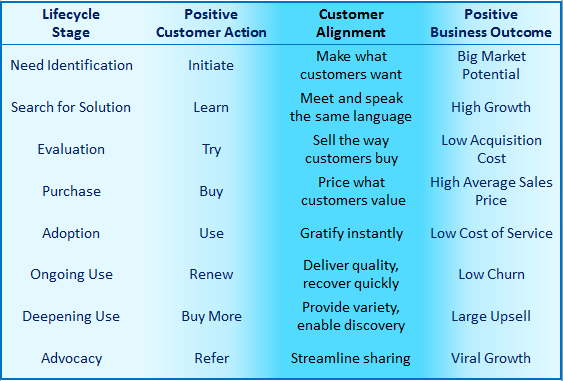When I’m not completely absorbed with my agile marketing software startup, I do a bit of SaaS consulting on the side. SaaS colleagues come to me with a wide variety of problems from positioning to sales compensation to churn analysis, but lately I’ve noticed a common theme: poor SaaS customer alignment. SaaS businesses develop intimate, long term relationships with their customers that are enabled by the always-on connection between the SaaS customer and the SaaS business through the SaaS product. Like many long term relationships, it is founded on a recurring cycle of needs fulfilled and expectations met, or not. And I don’t just mean customer needs and expectations. There are two sides to every relationship. SaaS businesses need to make money as much as SaaS customers need to spend it. SaaS customer alignment means aligning the goals and actions of the SaaS customer with the goals and actions of the SaaS business at every stage of the SaaS customer lifecycle.
This is the first post in a series that explores the importance of SaaS customer alignment. This first post introduces a simple framework for understanding SaaS customer alignment and its many benefits. Future posts will examine the challenges of achieving SaaS customer alignment in customer acquisition, customer success and early product market fit.

In SaaS, customers are the fundamental unit of measure. Each new customer brings a new thread of subscription revenue that is woven into a larger tapestry to form the total recurring revenue of a SaaS business. The quality of that tapestry hinges on the quality of your SaaS customers. But,what makes for a high quality customer? A high quality SaaS customer is aligned with your SaaS business goals and your SaaS business processes throughout the SaaS customer lifecycle. SaaS businesses that are well aligned with their SaaS customers have high recurring revenue growth, low acquisition costs and low churn rates. Poorly aligned SaaS businesses struggle to survive and satisfy their customers.
When your SaaS business is well aligned, your SaaS customers consistently take positive actions that lead to positive business outcomes: they try, they buy, they upgrade and they refer you to a friend. When you are poorly aligned, your SaaS customers consistently take negative actions that lead to negative business outcomes: they bounce, they negotiate, they complain, and they churn. In theory, the solution is simple: just get your customers to take positive actions. In practice, it’s a little more complicated.

When your SaaS business is well aligned, your SaaS customers
consistently take positive actions that lead to positive business outcomes.
Know Thy SaaS Customer
The good news about actions and outcomes is that they are easily measured. The bad news is that they are not as easily managed. Achieving strong SaaS customer alignment requires the ability to manage SaaS customer actions toward the positive and away from the negative. To do this, you have to understand the underlying motivations for those actions. You have to know how your customers think and why they do the things they do. That means you have to get meaningful and deep feedback from your customers at each stage of the SaaS customer lifecycle—real people. Clickstreams just don’t cut it.
That said, it is next to impossible to get inside the head of every single SaaS customer at scale. At each stage of the SaaS customer lifecycle, the SaaS business learns a little more about the SaaS customer and the SaaS customer learns a little more about the SaaS business. Not all of this information is useful or relevant. The key to scaling SaaS customer alignment is to link your understanding of real-world customer motivations to motivational indicators that are more easily measured.

The key to SaaS customer alignment is to link real-world customer motivations
to motivational indicators that are more easily measured.
The table above provides a strawman example of what I mean by linking motivation to measurable motivational indicators. What I call ‘motivational indicators’ go by a lot of different names, e.g., demographics, clickstreams, qualification criteria, pain points, or if you are a statistician: independent variables. In the early stages of the SaaS customer lifecycle, you have very little information about the prospect, so the indicators are largely demographic or early buying behaviors. Later in the SaaS customer lifecycle, you get access to product usage data and direct customer feedback. By the time they are renewing customers, you usually have more data than you can reasonably deal with. The two main takeaways are that the measures only matter if they are indicators of positive customer actions and they will only indicate positive customer actions if they are measures of customer motivation. Most demographics are meaningless.
The two most common roadblocks to achieving SaaS customer alignment are that a SaaS business either a) doesn’t talk to its SaaS customers on a regular basis to understand their underlying motivations at each stage of the SaaS customer lifecycle or b) doesn’t link real-world SaaS customer motivations to the oceans of data coming out of marketing, sales and support systems. Predictive models are developed by throwing spaghetti at the wall to see what sticks without any real understanding of why they work, or more often why they don’t.
If It Quacks like a Duck
If you can make a detailed table of motivational indicators by correlating direct customer feedback with your available process metrics, then you are halfway to SaaS customer alignment. The first thing you will notice is that your customers tend to fall into buckets based on specific bundles of motivations and motivational indicators. Like the indicators themselves, these buckets also go by many names: market segments, customer profiles, buyer personae, churn cohorts, or again if you are a statistician: customer populations.
A common mistake is to create arbitrary customer populations based on off-the-shelf demographics that do not indicate any real SaaS customer motivation, such as industry. This doesn’t mean demographics like industry are bad. Its just that you are likely to find that there are five industries that matter, because those SaaS customers have specific motivations that align with your SaaS business. And, fifty industries that don’t matter, because they don’t indicate anything other than an absence of positive motivations. Focus on the five.
Another common mistake is to create customer populations based on internal criteria, such as date of purchase, that corrupt pure external customer motivations with the internal actions of the SaaS business itself. When buckets are created this way, they say as much about your marketing, your product, your sales and your support as they do about your SaaS customer. These measures are useful when you are trying to determine the effectiveness of marketing programs and changes to your product, but they should not be used to describe your SaaS customers.

Once you can create meaningful buckets of motivational indicators, then the next most important thing to do is to give each SaaS customer type a simple, highly descriptive name. This small thing will do wonders for your SaaS business. When you give your high quality customers a name, it changes how you think and communicate about your SaaS business. Because industry doesn’t matter if industry doesn’t indicate motivation. Customer profiles don’t matter if they don’t profile motivations that lead to positive business outcomes. On the other hand, if it walks like a duck and it quacks like a duck, then it must be a duck! Call it a duck. When you can discuss your customers efficiently in a shorthand that describes their motivations, i.e., ducks need to quack, birds need to fly, firemen need to put out fires, bakers need to bake, truckers need to deliver, SaaS executives need to make money, etc. then you will find yourself making better, fast business decisions that consistently improve SaaS customer alignment.

[…] compilation of recent popular articles at Chaotic Flow, this detailed eBook outlines the important SaaS marketing concept of SaaS customer alignment. It […]
[…] compilation of recent popular articles at Chaotic Flow, this detailed eBook outlines the important SaaS marketing concept of SaaS customer alignment. It […]
[…] SaaS businesses can be overwhelmingly complex. If the multi-tenant, cloud-based technology isn’t enough, there’s the recurring revenue model which creates all kinds of challenges from accounting to sales compensation to funding. Then, there’s the marketing. Getting noticed on the Internet gets harder every year and almost every SaaS product category has a crowded field of competitors. And of course there is mobile, which should come first right? In my own SaaS experience, be it scaling a sales and marketing team, consulting for SaaS startups or bootstrapping my agile marketing SaaS, Markodojo, I find myself returning to a common theme that always cuts through the complexity: SaaS customer alignment. […]
Great post, Joel. At times, I think we all get caught up in the conspiracy of “growth at all costs” whereby we sell to customers who might not be a perfect match. And that outcome only becomes evident in retrospect. It takes a very disciplined and well-aligned leadership team (and board) to implement what you suggest. Maybe some thoughts from you on how to achieve that alignment would be a great next blog?